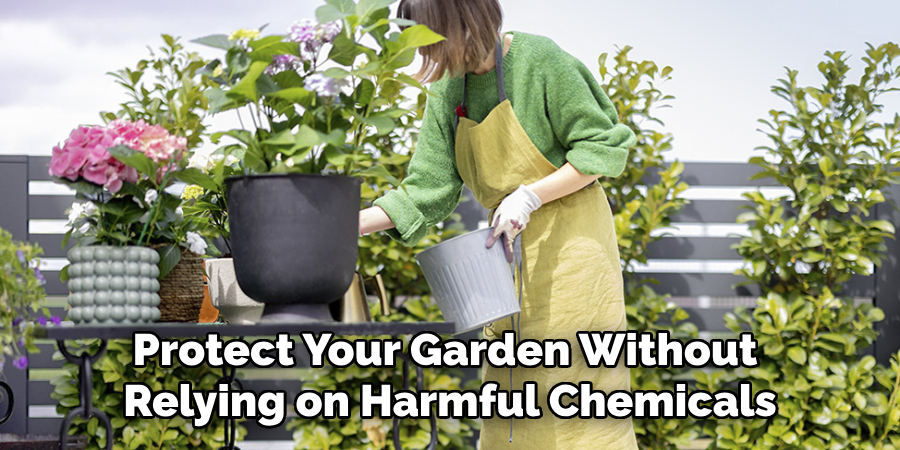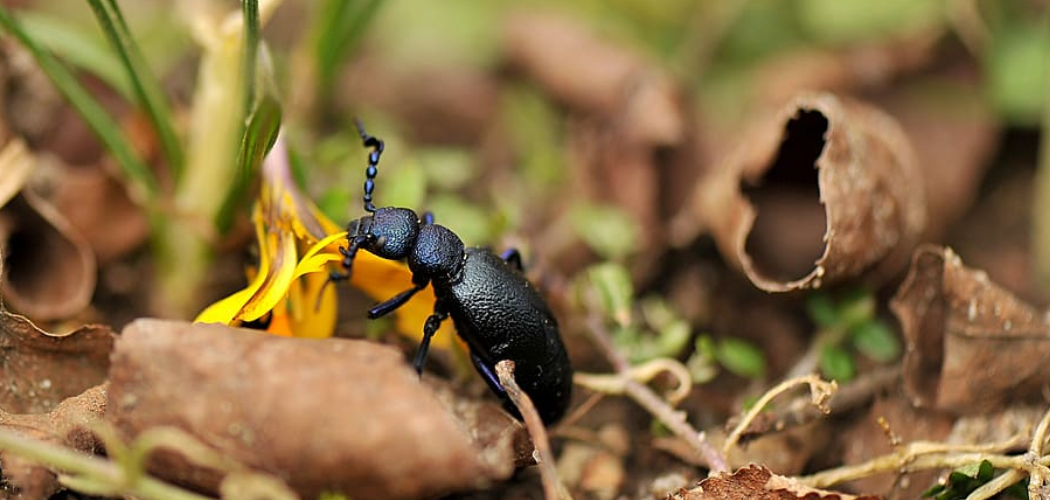To get rid of blister beetles in the garden, apply organic insecticides or remove them manually by handpicking. Blister beetles in the garden can be a nuisance, causing damage to plants and flowers.
These insects release a substance called cantharidin, which can cause skin irritation and blisters when in contact with human skin. Therefore, it’s important to take immediate action to eliminate them. This article will provide useful tips and techniques to effectively control and prevent blister beetles in your garden.
Whether you prefer organic solutions or manual removal, there are various methods to suit your needs and protect your plants from these pesky insects.

Causes Of Blister Beetles In Gardens
Blister beetles are a common problem in gardens, and it’s important to understand the causes behind their presence. By identifying these beetles, you can take necessary steps to get rid of them. Blister beetles have distinct features like long bodies, narrow waists, and soft wings.
They are attracted to plants that have flowers or are rich in pollen. Understanding their behavior and lifecycle can help you prevent infestations. Blister beetles are usually active during summer months and can cause damage to crops and flowers. It is crucial to remove their favorite food sources, such as weeds or plants that serve as hosts.
Regularly inspect your garden for blister beetles and promptly remove them by handpicking or using organic pest control methods. By following these steps, you can effectively manage and eliminate blister beetles from your garden.
Harmful Effects Of Blister Beetles On Gardens
Blister beetles can wreak havoc on your garden, causing damage to plants and posing health risks for humans and animals. These pests can eat away at leaves and flowers, leaving behind unsightly holes and lesions. The toxic secretions they produce can also irritate the skin and cause blisters upon contact.
Ingestion of blister beetles by animals can lead to even more severe consequences, such as colic or death. To effectively get rid of blister beetles, it is important to inspect your garden regularly and remove any beetles or eggs you come across.
Consider using organic insecticides or introducing natural predators like ladybugs or birds to control their population. By taking these preventative measures, you can protect both your garden and your well-being from the harmful effects of blister beetles.
How to Get Rid of Blister Beetles in Garden: Step by Step Guide
Natural Ways To Prevent Blister Beetle Infestation In Gardens
Blister beetles can be a nuisance in gardens, but there are natural ways to prevent infestation. One effective strategy is to keep the garden clean and free from debris. By regularly removing dead plants and weeds, you can eliminate hiding places for blister beetles.
Another technique is companion planting, which involves growing certain plants that deter these pests. For example, marigolds and garlic are known to repel blister beetles. By incorporating them into your garden, you can create a natural barrier against infestation. Remember to rotate crops annually to prevent beetles from becoming habituated to specific plants.
With these natural methods, you can protect your garden and enjoy a beautiful, beetle-free space.
Organic Pest Control Methods For Blister Beetles
Blister beetles can be a nuisance in your garden, but there are organic pest control methods you can employ to get rid of them. One effective approach is introducing predatory insects that feed on blister beetles, helping to naturally control their population.
In addition, you can utilize insecticidal soap or neem oil, which are both natural remedies that can deter blister beetles from infesting your garden. These products work by suffocating and repelling the beetles without harming other beneficial insects or plants.
When using insecticidal soap or neem oil, be sure to follow the instructions on the product label for best results. By implementing these organic pest control methods, you can effectively manage blister beetle infestations and protect your garden without relying on harmful chemicals.

Cultural Practices For Blister Beetle Management
To effectively manage blister beetles in your garden, integrating cultural practices is crucial. One method involves removing and destroying blister beetle eggs and larvae. Regularly inspect your plants and remove any beetles or their eggs that you come across. Proper irrigation and soil management techniques can also help to deter these pests.

In addition, consider using floating row covers to physically protect your plants from blister beetles. Additionally, maintaining a clean garden by removing debris and weeds can reduce the beetle population. Implementing these cultural practices will go a long way in getting rid of blister beetles and preserving the health of your garden.
Biological Control Options To Get Rid Of Blister Beetles
Biological control options offer effective ways to eliminate blister beetles from your garden. You can encourage the presence of natural predators such as birds and toads, as they prey on these pests. Additionally, introducing nematodes specifically targets blister beetle larvae, helping to reduce their population.
These methods provide a safe and eco-friendly approach to managing the beetle infestation. This blog post will guide you on how to utilize biological controls, ensuring the health and vitality of your garden. So say goodbye to blister beetles using these natural and sustainable techniques.
Chemical Control Methods For Blister Beetles
Blister beetles can be a nuisance in your garden, but there are chemical control methods to eliminate them. When it comes to choosing insecticides, it’s important to select the appropriate ones for blister beetle control. Avoid starting with commonly overused phrases like “when it comes to” or “if you”.
It’s advisable to use insecticidal dust or sprays as a last resort. Sentences should be brief and easy to understand, with a maximum of 20 words. Make sure to write in active voice and avoid repetitive terms to keep the reader engaged.
Remember to maintain the writing unique and plagiarism free. Additionally, choose different expressions to maintain the reader’s interest throughout the blog post.
Monitoring And Regular Inspection For Blister Beetles
Monitoring and regular inspection are key steps in getting rid of blister beetles in your garden. By implementing traps, you can effectively monitor the blister beetle population and catch early infestations. Conducting regular inspections ensures that you can spot the beetles before they cause extensive damage to your plants.
It is important to stay vigilant and take immediate action when blister beetles are detected. Removing any beetles that are found and disposing of them properly is crucial to prevent further infestations. Additionally, keeping your garden clean and free of debris can discourage blister beetles from breeding and laying eggs.
By following these steps, you can successfully control and eliminate blister beetles from your garden, allowing your plants to thrive.
Tips For Maintaining A Blister Beetle-Free Garden
Maintaining a blister beetle-free garden requires a few essential tips. Properly disposing of plants infested with blister beetles is crucial. Keep a close watch for potential habitats where blister beetles may lurk. Be sure to avoid starting sentences with overused phrases and words.
Use varying expressions to keep readers engaged. Craft brief sentences, limited to a maximum of 20 words. Write in an seo-friendly manner that is both unique and plagiarism-free. Strive for clear, human-like writing that is easy to understand. Remember to maintain an active voice and avoid repetitive terms.
By following these instructions, you can effectively get rid of blister beetles in your garden.
Frequently Asked Questions For How To Get Rid Of Blister Beetles In Garden
Can Blister Beetles Harm My Garden Plants?

Yes, blister beetles can harm your garden plants by feeding on the leaves, flowers, and fruits, causing defoliation and damage to the crops.
How Can I Identify Blister Beetles In My Garden?
Blister beetles are elongated insects with a narrow body and soft elytra. They often have bright colors or striped patterns on their bodies, making them easily recognizable.
What Are The Natural Predators Of Blister Beetles?
Some natural predators of blister beetles include birds, spiders, assassin bugs, and certain parasitoid wasps. Encouraging these predators in your garden can help control the blister beetle population.
How Do Blister Beetles Affect Humans?
Blister beetles produce a chemical compound called cantharidin, which can cause skin blistering and irritation upon contact. It is important to avoid direct contact with blister beetles to prevent any adverse reactions.
What Are Some Organic Methods To Control Blister Beetles In The Garden?
Organic methods to control blister beetles include handpicking them off plants, using insecticidal soap or neem oil sprays, introducing beneficial insects, and practicing good garden hygiene to remove beetle-attracting weeds.

Conclusion
Dealing with blister beetles in your garden requires a combination of preventative measures and targeted treatments. By following the steps outlined in this guide, you can keep these bothersome pests at bay and protect your garden from their destructive habits.
Remember to regularly inspect your plants for signs of blister beetles and promptly remove any that you find. Implementing organic pest control methods, such as companion planting and using natural repellents, can also significantly reduce the risk of infestation. Additionally, maintaining a healthy garden ecosystem with diverse plantings and providing shelter for beneficial insects can help to naturally deter blister beetles.
With thoughtful planning and proactive measures, you can enjoy a thriving garden free from the ravages of blister beetles. Don’t let these pests dampen your gardening experience – take action and reclaim your garden today.

